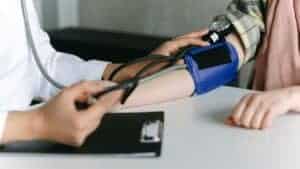If you’re like the millions of other Vets in the nation, you’re probably traveling a lot for healthcare. No matter what you’re seeking help for or how long your commute is, VA travel pay can usually help you get reimbursed for the difference. Sound good? Learn more about it below!
Read next: Your Guide to Using My HealtheVet for Veteran Healthcare Needs
What Is VA Travel Pay?
VA travel reimbursement is money that the VA gives you to cover the cost of travel relating to approved healthcare visits for patients and caregivers. You can receive reimbursement for transportation, approved meals, and approved lodging expenses.
In this day and age, gas prices are skyrocketing, bus costs are expensive, plane tickets are astronomical, and every other form of transportation isn’t getting any cheaper. Luckily, this form of VA reimbursement is here to make sure you don’t go broke just for trying to stay healthy.
Do I Qualify For VA Travel Pay?
VA travel pay eligibility is for Veterans and their caregivers who are “traveling for care at a VA health facility or for VA-approved care at a non-VA health facility in your community.”
Additionally, to receive VA travel pay, at least one of the following statements must be true:
- Your VA disability is at 30% or higher.
- You’re traveling for a service-connected health issue (even if your rating is under 30%).
- You receive a VA pension.
- Your income is less than the maximum annual VA pension rate.
- You cannot afford your travel expenses.
- You’re traveling to get a service dog, for VA-approved transplant care, or for a scheduled VA claim exam.
For caregivers, at least one of the following statements must be true if they’re providing care for a Veteran or non-Veteran:
- “The person is your family caregiver under the National Caregiver Program traveling to receive caregiver training or to support your care.
- That individual is your medically required attendant traveling with you to support your care.
- The person is your transplant care donor or support person.”
VA Travel Pay Deductible
If you’re looking for payment for travel related to healthcare, keep in mind that, like your health insurance, you’ll be required to pay a deductible before being paid for any travel expenses.
Currently, the deductible for a one-way trip for an appointment is $3, whereas a round-trip appointment will cost you $6. The payment won’t go above $18 power month.
But why charge a deductible at all? According to the VA, this is a requirement, as they must withhold a certain amount of money from travel reimbursement payments. This money goes toward assisting with travel and medical care for other Veterans.
For many Veterans with low incomes, they may not have to make this payment. Reach out to your local beneficiary office to see if they may be willing to waive the deductible.
How To Get VA Travel Pay
Logging In
Before you earn your travel pay, you have to set a few things up. First, you’ll need to create a VA travel pay login via Veteran Travel Claim Entry (the VA travel pay portal). You can start the process here.
Then, you’ll want to use one of the following existing login platforms or create an all-new login for one of the platforms to get started:
- DS Logon
- VA PIV Card
- ID.me
- LOGIN.GOV
- My HealtheVet
However, there are more options you can choose from, which can be seen on their category page.
Setting Up a Direct Deposit
After logging in or creating an account, you need to set up direct deposit for easy pay. You can do this by filling out VA Form 10091, for which you’ll need your bank’s name, address, and routing number in addition to your own account number (and whether it’s checking or savings), address, and social security number.
Then, you can fax your completed form to 512-460-5221 or bring it in person to your local beneficiary travel office.
After submitting your form, log in to your travel claim profile and double-check that the information for your direct deposit is correct. If it’s not, you can click “Request Profile Updates” to make any necessary changes.
If you’re using BTSSS VA travel pay for reimbursement, check out this video from the VA to get started with direct deposit and payments:
Keep Track of Receipts
When you’re traveling for healthcare expenses, make sure you get a copy of all your receipts and keep them in a safe location. Additionally, track your car’s mileage by writing down the mileage before and after your trip and calculating the difference.
Additionally, the mileage reimbursement rate is 41.5 cents per mile.
Other eligible costs you should keep receipts for include:
- Road tolls.
- Parking.
- Taxi fares.
- Plane tickets.
- Bus, subway, or train tickets.
- Meals and lodging, in specific cases.
Filing a Claim With the VA Travel Pay Form
Once you’ve completed the steps above, it’s time to file your claim.
To file your VA travel pay claim, you’ll need to log in to your Veteran Travel Claim Entry account as before. From there, you’ll submit your receipts and mileage.
Keep in mind that you must submit a claim within 30 days of the expense to be eligible for reimbursement. Furthermore, if you try to file a claim outside of that window, you will not be paid for your travel expenses.
How To Check on VA Travel Pay
You might also want to know how to check on VA travel pay after you’ve filed your claim. You can visit your account for VA travel pay online to check on the status of your payment or call your local beneficiary office.
Once your VA travel pay reimbursement has been approved, it will be automatically deposited through your bank account via an electronic funds transfer (EFT), and there will be no need for further action from you.
VA Travel Pay Problems
Unfortunately, there are issues users may run into from time to time. This includes reports of Veterans not being notified of the submission deadline and policy changes during the pandemic era.
To avoid common problems, be sure to file your claim within 30 days of incurring the expenses. Otherwise, the VA is likely to deny reimbursement as the extensions during COVID-19 expired on June 9, 2023.
Additionally, there have been multiple reports of issues using the VA’s online travel reimbursement system accepting claims due to the inability to properly fill out the form. For example, a healthcare professional or facility not being listed online.
Despite the BTSSS aiming to handle 90% of the claims from Veterans effectively, government oversight reports show that these goals have not been met.
Developed by Liberty IT Solutions, which is now a subsidiary of Booz Allen Hamilton, Veterans, and staff alike continue to experience VA travel pay problems using BTSSS.
Measures to improve these issues are already underway, including the use of kiosks using a different app, VetLink, that is being tested at various VA sites throughout the country, including Charleston, South Carolina.
If you are experiencing issues, call the toll-free VA travel pay problems phone number Monday through Friday from 8:00 a.m. to 8:00 p.m. ET at 1 (855) 574-7292 (TTY: 711) for assistance.
While VA travel pay reimbursement options are less than perfect, they do exist. Therefore, be sure to document your expenses, be prepared for filing over the phone should you experience issues online, file within 30 days, and reach out for help as soon as possible to avoid being denied.
Suggested read: Hazardous and Toxic Materials PACT Act Expansion Starts March 5, 2024
Sources:
- VA travel pay reimbursement, VA. Accessed March 2024. https://www.va.gov/health-care/get-reimbursed-for-travel-pay/
- Goals Not Met for Implementation of the Beneficiary Travel Self-Service System, CIGIE. Accessed March 2024.
*Updated by Buddy Blouin 3/1/2024






